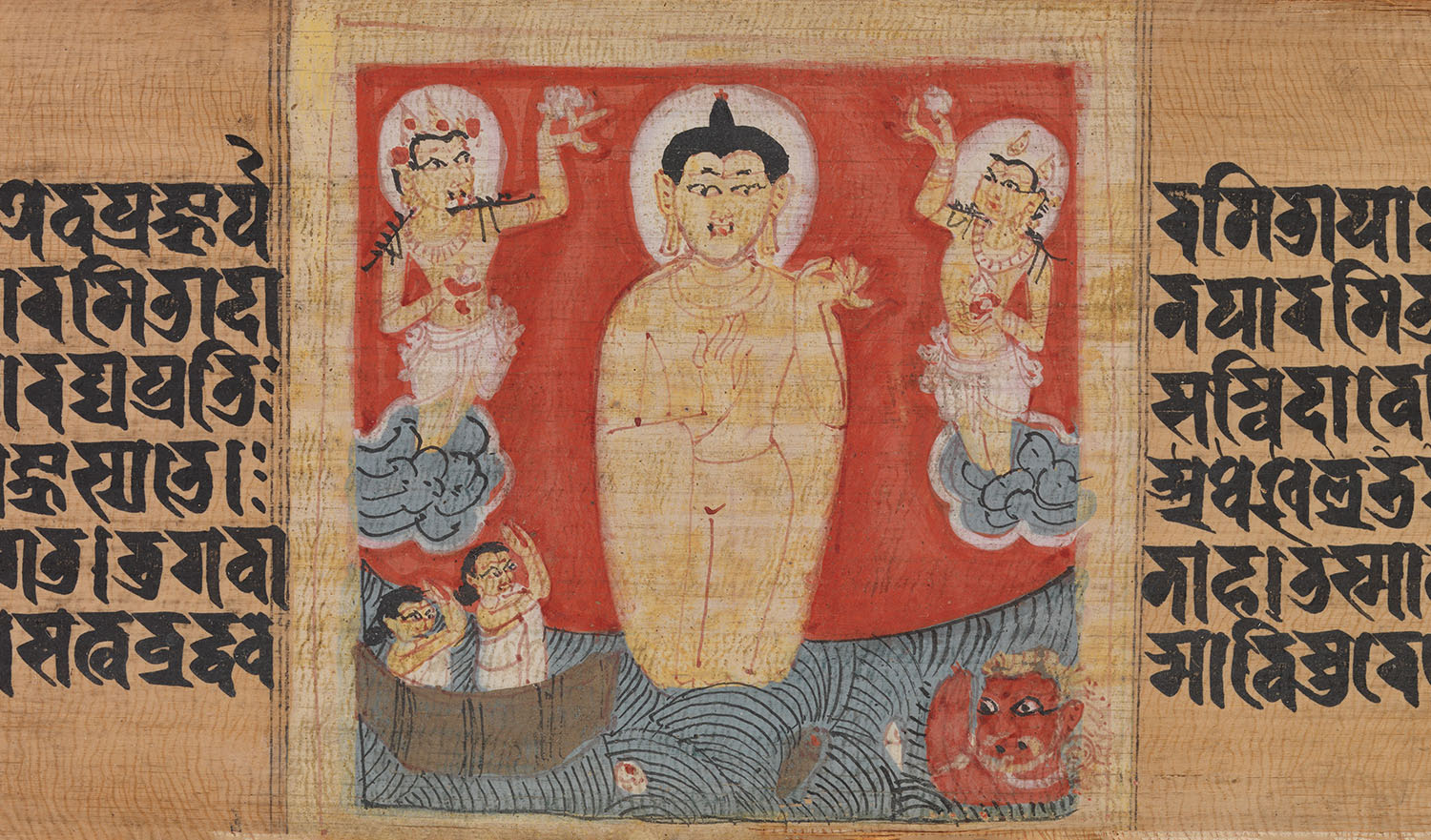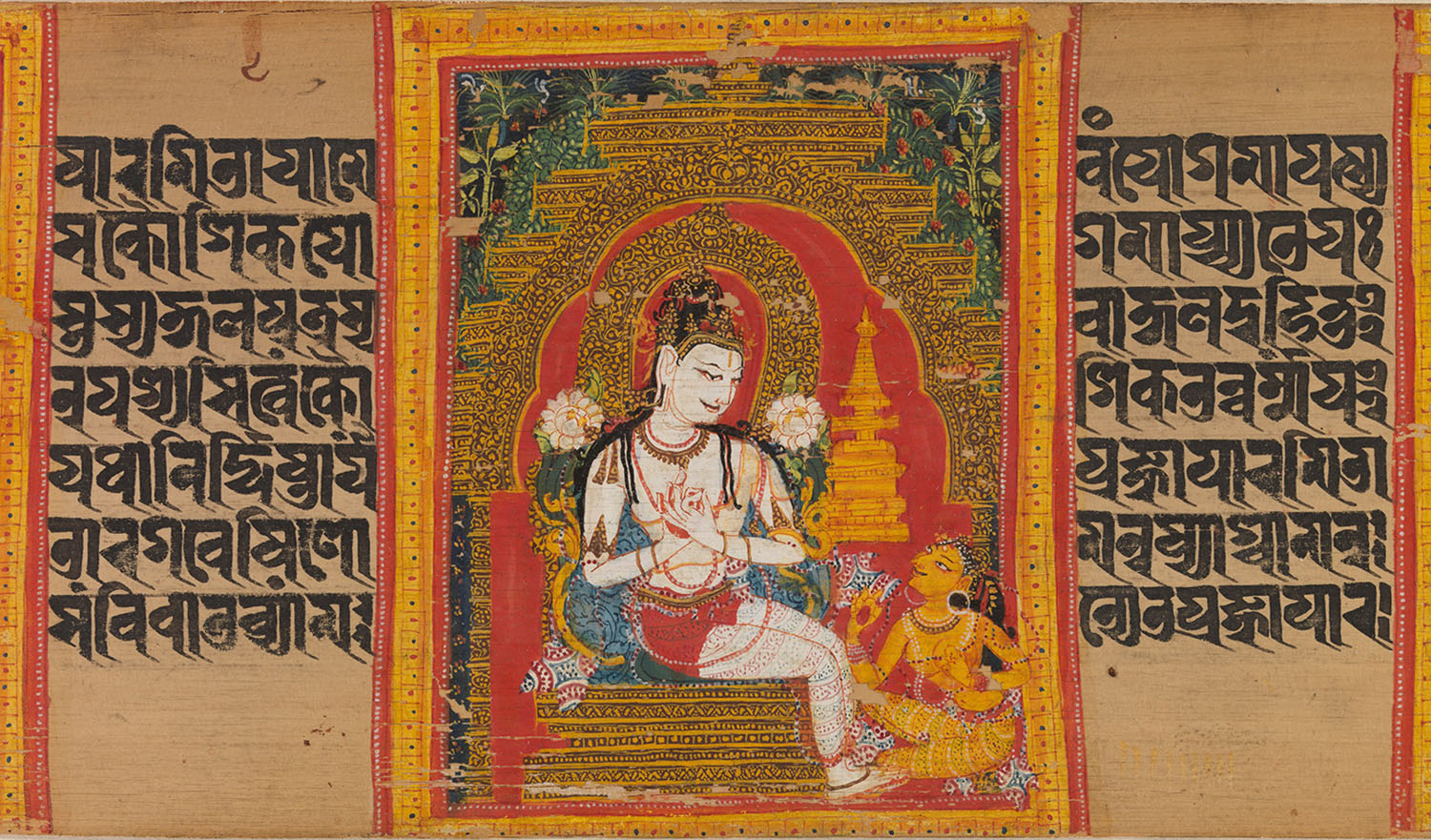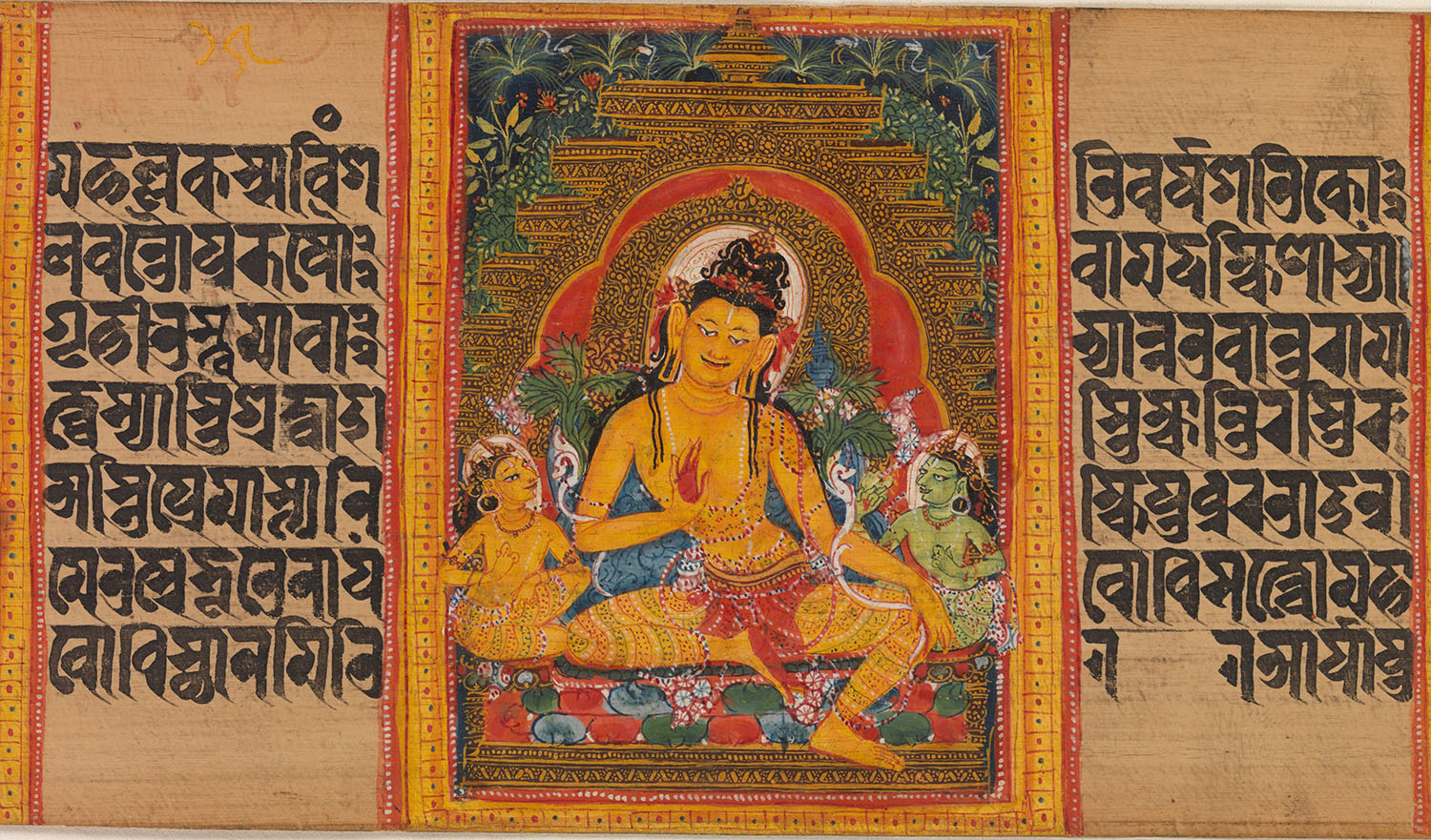ARTICLE
Pala Manuscript Painting
Considered among the earliest surviving illustrated manuscripts of South Asia, palm-leaf manuscripts on Buddhist themes were an important part of the aesthetic patronage of the Pala empire, which extended over the eastern part of the Indian subcontinent between the eighth and twelfth centuries CE. Under the Pala dynasty, the modern-day regions of Bihar, West Bengal, Nepal and Bangladesh became flourishing centres for the study and dissemination of Mahayana Buddhism, nurturing a stylistic school of bronze and stone sculpture, architecture and painting. Informed by Buddhist iconography and visual idioms from the temple sculptures and murals of the period, artists in these regions created manuscript paintings largely for the Mahayana texts Ashtasahasrika Prajnaparamita (‘The Perfection of Wisdom in Eight Thousand Verses’) and the Jataka tales, and some for texts of the Vajrayana sect, such as the Pancharaksa (‘The Five Protective Goddesses’), Karandavyuha sutra and Kalachakra-tantra. Their vision and skill in miniaturising the expansive, now-lost mural paintings of the time marks a significant achievement in the evolution of the miniature painting tradition in the Indian subcontinent, influencing the painting styles in regions as dispersed as Kashmir, Tibet and Southeast Asia.
These manuscripts were largely produced in the Pala-patronised mahaviharas or great monastic centres of Vikramashila, Nalanda and Kurkihar in modern-day Bihar, presumably by the resident monks, and parts of present-day Bangladesh where the Yadava-Varman dynasty reigned from the mid-eleventh to mid-twelfth century. They were commissioned by monks — some of whom are named in manuscripts as Sthavira, Upasaka and Bhiksu — as well as high-ranking lay persons seeking spiritual blessings for themselves and their families. Sections of the manuscripts have been found not only from these sites but also in Northeast India and present-day Bhutan, Nepal, Tibet and Southeast Asian states like Myanmar and Thailand, where Buddhism was disseminated. Missionaries and scholars such as Atisha, Shantarakshita and Tilopa are known to have travelled to these regions from the Pala empire, and would have taken the manuscripts with them. They were produced not only to preserve and propagate the tenets of Buddhism but also as ritual objects used for the invocation of deities during worship — as evidenced by the thickly daubed layers of vermillion, sandalwood paste, oil and milk found on the covers of many of these manuscripts.
The manuscripts were made using leaves of the talipot palm (Corypha umbraculifera) that were encased between cover panels, usually of wood and occasionally more precious materials such as copper or ivory. The palm fronds were cut into narrow rectangles about 5 centimetres wide and 50 centimetres long; flattened and rubbed down with a stone; and covered with a layer of primer to form the manuscript pages, or folios. The text was inscribed or painted onto them, in densely packed calligraphy, the script varying by region. The finished folios were pierced and bound together with a cord, and placed between the wooden boards, which were painted and varnished.
With the emphasis largely on the text — both for its sacred content and the meritorious and ritually significant act of copying it — the painting of images occupied a secondary position, and the pages themselves often had no illustrations. The insides of the cover panels often bore images, while the outsides were largely painted with decorative floral patterning. For folios that would contain images, the process of painting followed that of writing; images would be painted into spaces measuring roughly 5 x 7 centimetres, allotted to them between columns of text. Illustrated folios commonly held three such images each, equally spaced on the horizontal panels. While the names of the scribe and the donor commissioning the manuscript were mentioned on the colophon, alongside the year and place of the manuscript-making, the artist was never credited in these manuscripts.
Moreover, the paintings in the manuscripts do not directly illustrate the texts they accompany, instead serving as iconic representations of principal Buddhist themes. They are largely restricted to depictions of events from the Buddha’s life, specifically the Eight Great Events, which were canonised in the region by the ninth century — the Buddha’s birth; enlightenment; first sermon; acceptance of honey from a monkey at Vaishali; taming of Nalagiri the elephant; descent from the celestial plane Tavatimsa heaven; multiplication of himself at Shravasti; and death. Deities of the Mahayana as well as the Vajrayana sects, such as Tara, Maitreya, Lokanatha, Marichi and Vajrapani, are also found in the manuscript paintings.
The figures in the paintings typically show strong silhouettes and a clear definition of forms. Initiated with black or red outlines, they are painted in with layers of flat colour. Backgrounds are rendered in flat colours, with the figures occupying a single plane. Tonal variation and contours are achieved by overlaying progressively darker tones in different areas of the figures, creating a degree of modelling. Finally, forms and facial features are emphasised with black outlines. A hierarchy between the deity and the devotees is established through their relative positions and sizes in the composition. Whilst the Buddha’s face is represented frontally, others are usually depicted in three-quarter profile.
The colours were derived largely from mineral sources — white from burnt conch shells, yellow from orpiment, blue from lapis lazuli, and vermilion from cinnabar. These, along with green pigment, crimson from madder root, and black from soot, formed a palette that corresponded with the Buddhist iconographic conventions of the time.
The manuscript paintings made during the reigns of Mahipala (r. 988–1038) and Nayapala (r. 1038–55) constitute an early phase of the tradition, known for its close association, and even imitation, of the ideals of mural paintings of the period. The figures of this phase are relatively flat and angular, with delicate lines, and features such as the eyes exaggerated in proportion to the face. The paintings of this period, executed in subdued colours, also featured crowded compositions with multiple figures occupying the frame.
From the late eleventh century onwards, around the period of the rule of Ramapala (r. 1077–1120), manuscript painting entered its mature phase, with more spacious compositions and greater fluidity of figural forms. This phase is marked by a distinctive emphasis on the fullness and suppleness of the figure, especially in the representation of female deities, and more saturated colours. Scholars have also pointed to two regional variations in the paintings of this phase. The paintings executed closer to the Pala capital in the Magadhan centres of modern-day Bihar, such as Nalanda, constitute the northern style, also known as the Varendra style — characterised by bold, hard lines and ornate compositions. They sometimes depict figures of donors or patrons and their family members painted along the periphery of the main illustration panels. The manuscripts here employed the formal Siddhamatrika Brahmi script also known as Ranjana or Kutila (‘hooked’ or ‘crooked’, referring to the shape of the letters).
The southern — or Vanga style — was centred around present-day Munshiganj district of Bangladesh, the capital of the Yadava-Varman dynasty, which by this time sought peace with the Palas. It is known for the simplicity of its pictorial style, minimal decorations and bold application of tonally flat colours. Vanga manuscripts were written in a proto-Bengali Gaudiya script, rather than the Kutila script preferred in the north. The difference between two extant Prajnaparamita manuscripts — produced eleven years apart in the eleventh and twelfth centuries, under the Yadava-Varman ruler Harivarmadeva — demonstrate the stylistic shift between the early and late phase.
Pala manuscript painting traditions declined towards the end of the twelfth century, when Turkic rulers began to establish their rule over present-day West Bengal, Bangladesh and parts of Bihar. However, the dissemination of Buddhism ensured that some of Pala manuscripts travelled to Nepal, Tibet, Kashmir in South Asia and Thailand in Southeast Asia, where they inspired local adaptations of the style in murals and manuscripts. The Bharat Kala Bhavan and The Asiatic Society of Bengal hold some Pala manuscripts, particularly of the Prajnaparamita Sutra, dating back to the eleventh and twelfth centuries.
Bibliography
Agrawala, Vasudeva S. The Heritage of Indian Art: A Pictorial Presentation. New Delhi: Publications Division, Ministry of Information & Broadcasting, 1964.
Banglapedia. “Pala Painting.” Accessed March 21, 2024. https://en.banglapedia.org/index.php/Pala_Painting.
Britannica. “Pala Art.” Accessed December 10, 2021. https://www.britannica.com/topic/Pala-art.
Chaitanya, Krishna. A History of Indian Painting. New Delhi: Abhinav Publications, 1976.
Chakraverty, Anjan. Indian Miniature Painting. New Delhi: Lustre Press, 2005.
Guy, John. “From Palm-Leaf to Paper: Manuscript Painting, 1100–1500.” In Wonder of the Age: Master Painters of India, by John Guy and Jorrit Britschgi United Kingdom: Metropolitan Museum of Art, 2011.
Huntington, Susan L. and John C. Huntington. “Leaves from the Bodhi Tree: The Art of Pāla India (8th-12th Centuries) and Its International Legacy.” Orientations 20, no. 10 (1989): 26–46.
Kim, Jinah. “Illustrated Buddhist Manuscripts.” In History of Bangladesh: Early Bengal in Regional Perspectives (up to c. 1200CE), edited by Abdul Momin Chowdhury and Ranabir Chakravarti, 509–534. Dhaka: Asiatic Society of Bangladesh, 2018.









